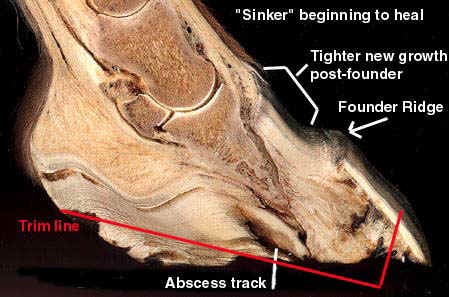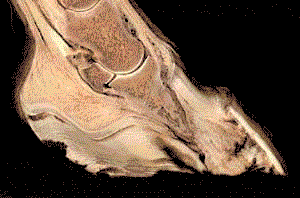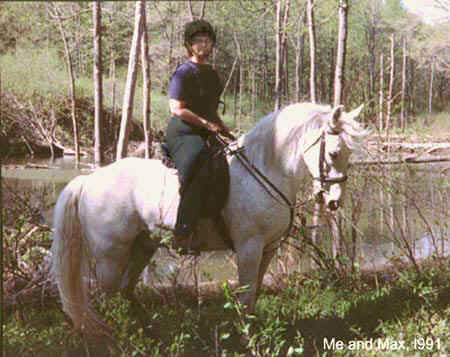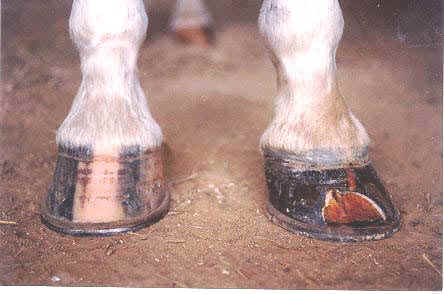
Treating Founder (Chronic Laminitis) without Horseshoes, Section 6
(Version with full-sized photos)
Here is an inside view of what we are trying to accomplish trimming a foundered horse:


(Specimen from Horse Sense Biological Specimens, 508-352-6336)
Lowering the heel and removing leverage on the toe by backing up its profile--see red line.
The above image shows using a trim to treat chronic laminitis:
1. Lowering the heels:
a. Restores the physiologically correct ground parallel position to the bottom of the coffin bone, which stops overstressing the toe laminae.
b. Puts the frog on the ground where it belongs.
c. Encourages the heels to spread, increasing circulation.
d. Takes weight off the toe, proportionately, by transferring more weight further back on the foot.
e. Aligns the coffin bone less perpendicular to the ground, so it isn't poking through the sole. Bottom of coffin bone ground-parallel.
2. The base of support is moved back under the bone column by lowering the heels and backing up the toe. We are aiming for eventually tweaking the hoof into a rounded hoof print more like the preceding illustration from Dr. Strasser's book.
3. The leverage on the laminae is reduced by the toe being effectively shortened by being backed up.
4. The toe is shortened more by backing up its profile than by taking length off from the bottom of the foot.
5. The shape of the trimmed hoof is more compact from front to back.
6. Proper hoof shape restores hoof mechanism, which restores circulation.
To actually see more on circulation, there is a very interesting video on the subject by Dr. Christopher Pollitt, available from the Hoofcare and Lameness Magazine web site: www.hoofcare.com This is a worthwhile magazine, and they also offer a free online newsletter. There are many pro-high tech shoeing articles in it, though.
Dr. Pollitt's video very clearly illustrates what hoof mechanism looks like. He also shows how keg shoes reduce circulation, as compared with the circulation shown in the x-ray study footage.
Dr. Strasser's latest book, "Shoeing, A Necessary Evil?" disagrees with some of his conclusions, however:
"In 1993, Chris Pollitt of Australia published a video study of circulation in the hoof. In it, the difference in circulation in a shod and unshod hoof is shown, with varying coffin bone angles, and with the use of various pads (for example, wedge pads, etc.). The arterial circulation of the corium is clearly restricted in a shod hoof, and the blood flow uses alternate lateral branches--which, however, effect only scant circulation, and do not supply the entire corium sufficiently. (Sadly disregarding his own research, Pollitt continues to advocate orthopedic shoeing as the way to treat hoof problems.)"
The Horse's Hoof, News for Natural Hoofcare. This is an online newsletter dedicated to the natural hoof and holistic horse care.
The Horse's Hoof WEB SITE takes subscription orders. They have posted many links, contacts and articles of interest on their web site. They also are selling Dr. Strasser's books, and many other authors' books on hoof care. They carry farrier tools, boots, supplements, and other horse care products. (Online orders and credit cards accepted.)
Please send all requests, questions, article submissions and photos to:
Yvonne Welz, P.O. Box 1969, Queen Creek, AZ 85142
Phone: 1-877-594-3365
www.facebook.com/TheHorsesHoof
editor@TheHorsesHoof.com

These pages are dedicated to my cherished old horse, Max,
and are posted as a service to other foundered horses who may also benefit from them.
Sadly, I have to report that my old foundered horse, Max, died March 23, 2004. It was sudden, and while I was away. He was 30 years old, born June 10, 1973. Even a couple of days before, he seemed fine. He was still feisty enough to push my draft mule around. At the time of his death, he was bleeding heavily out of his nose and mouth, and collapsed. The neighbors buried him with their backhoe before I got home, so I never did have a chance to have a necropsy done to know for sure the cause of his death...or to even say goodbye. His teeth were not good, and he was starting to have trouble keeping weight on. But he survived more than 10 years after having sole penetration...his soles just filled back in and stayed that way. He has been such a good friend for so long, it is almost inconceivable that he is gone. Foundered horses all over the world have benefited from what he inspired me to learn and share with others. But to me, he was more of a dear friend than an honored catalyst for progress. No longer can I bury my face in his mane, which smelled so good, or look into his beautiful eyes. It will never be the same. He is missed so much by so many. My mule is just lost without him.
...Rest well, sweet prince!
I also believe these trimming techniques will have considerable value
preventing lameness and improving performance in sound horses.
Nutritional and medical treatments (and prevention) also discussed.
I want to thank Jaime Jackson, whose innovative
wild horse research has enabled me to help my horse.
He has written some helpful books: "The Natural Horse"
and "Founder: Prevention and Cure the Natural Way"
I also thank David Frederick, DVM, for his input and for
his permission to photograph his specimens and some of his patients.
Finally, I thank Dr. Hiltrud Strasser and her associate,
Sabine Kells, for their exceptionally informative
books, "A Lifetime of Soundness"
"Shoeing: A Necessary Evil?" and
"The Hoofcare Specialist's Handbook: Hoof Orthopedics
and Holistic Lameness Rehabilitation"
My contact info:
Send Email to Gretchen Fathauer, or call (740) 674-4492
P. O. Box 307, Duncan Falls, OH 43734, USA
About my phone number--I have "Privacy Manager" on my number, which screens calls from numbers that show up as "unlisted," "private," "blocked," or "unknown" on Caller ID. This was a practical necessity because it weeds out telemarketing calls that were getting more and more numerous and intrusive. It also kicks in when I get overseas calls from readers, though. After the recording prompts you to say your name, please do, and then give me enough time to answer. It then rings me, plays a recorded message, and then the recording of you saying your name. All this takes several rings. Because my phone is sometimes on call forwarding, please allow at least 4-5 rings, even if you are not calling from a blocked number.
Please--if you want to contact me, send me photos of your horse's feet. I am getting frustrated with people asking me questions about their horses when they give me nothing to go on.
Disclaimer: I have not completed the full Strasser hoofcare specialist certification program, and so I cannot officially speak for either Dr. Strasser or Sabine Kells. Further, I am not responsible for poor results when the method is applied piecemeal or the trim done incorrectly. I also do not claim to be a veterinarian. I am a horse owner living in a remote area; I was forced to learn about trimming and foundered horses by my circumstances. I chose to share what I learned on my web site, and have had so many people share their experiences and discoveries with me as a result of this site being out there. I have also continued to study other sources of information.
My horse, Max and his story:
My horse was foundered badly in ’93, and again to a lesser extent in ’95 and ’96. In ’93, initially, his rotation was 6 degrees. He was put in Thera-Flex pads, which gave him some relief. Then the farrier just dropped us and never came back. In the meantime, his toes got really long. Then he abscessed, so we had to pull the shoes. Farriers not showing up, etc., let his toes get even longer. Soon he was so sore he could barely stand. In desperation, I hauled him up to the veterinary school at Ohio State. His X-rays then showed 11 degrees rotation on the left and 7 degrees on the right. They taped some lily pads on him, but without also backing up his toes, so he got no relief until their farrier came, a few days later(!) to do a resection and put on heartbars with leather rim pads.
In retrospect, what got him so badly rotated was an over-long toe and high heels putting so much leverage on his already-weakened laminae. Farriers breaking appointments, long periods between resets, and farriers not backing the toes up enough all contributed to this increased leverage. Sometimes his toes were 4--1/2 inches long.
If only I knew then what I know now! I could have prevented enormous amounts of damage, and saved enormous amounts of money! All I had to do was just give him a wild horse-shaped trim at home, but often, and he would have recovered faster, and better. It is my hope that publishing my experiences will help other horse owners to avoid the pitfalls I was stuck in...and save their horses much suffering.

Max within 1 week of his resection at OSU, summer, '93;
in heartbars and leather rim pads.
Back to home page--Table of Contents
Article in sections with "thumbnail" photos for fastest downloads:
1 9 17
2 10 18
3 11 19
4 12 20
5 13 21
6 14 22
7 15 23
8 16 24
NAVICULAR
Article in sections with full-sized photos for print-outs:
1 9 17
2 10 18
3 11 19
4 12 20
5 13 21
6 14 22
7 15 23
8 16 24
NAVICULAR
To Strasser case studies--thumbnail photos for faster downloads
To Strasser case studies--large photos
Please sign my guest book! Photos of my pets My farm
Share Barefoot success stories on this page
Buy or sell used HORSE BOOTS Natural board Barn Listings
Click here to subscribe to naturalhorsetrim
(I moderate this listserv to weed out "fluff.")
Send Email to Gretchen Fathauer, or call (740) 674-4492
Copyright by Gretchen Fathauer, 2015. All rights reserved.